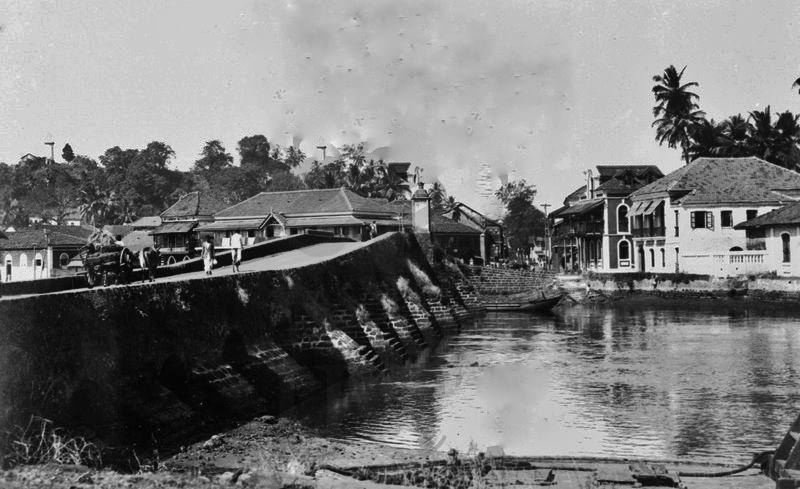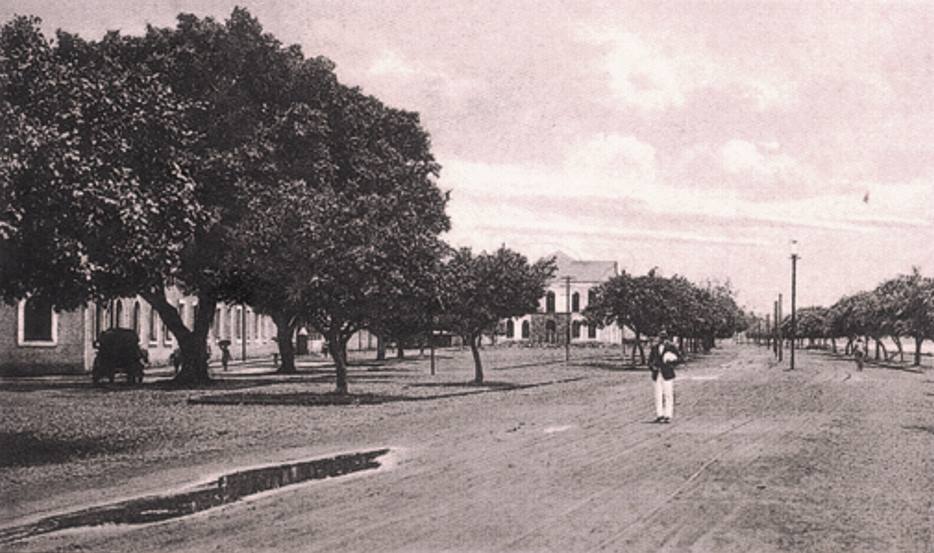By Selma Carvalho
The year 1846 had been particularly difficult on India’s northern front. The winter had been cruel, there were frequent shootings, and the cholera-ridden summer proved to be hot and sickly for the young army recruit (later to become one of England’s most notable explorer) Richard Burton. Still, his illness was not debilitating enough to warrant a return to England. In September of 1846, he was moved to the sick barracks. He presented himself to the Medical Board in Bombay and with the help of his friend Henry J. Carter, who at the time was a member of the board, he persuaded the army to grant him sick leave. During this time Burton would travel to Goa and the Nilgiris. His travels resulted in the publication of that relentlessly uncharitable book Goa and the Blue Mountains published in 1851. A description of Panjim in the book begins thus:
There are many respectable-looking houses, usually one story high, solidly constructed of stone and mortar, with roofs of red tile, and surrounded by large court-yards overgrown with cocoa-nut trees. Bungalows are at a discount ; only the habitations of the poor consist solely of a ground floor. In general the walls are whitewashed,—an operation performed regularly once a year, after the Monsoon rains ; and the result is a most offensive glare. Upon the eminence behind the town is a small telegraph, and half-way down the hill, the Igreja (church) de Conceição, a plain and ill-built pile, as usual, beautifully situated.
For much of the book, what is obvious is Burton’s northern European disdain for anything a southern European colonial power could achieve. Burton wrote travelogues like most travel writers; undoubtedly he’d read up on Goa before visiting it and much of his observations yielded to the preconceived notions he harboured. Despite Burton’s biases, he does leave us with a fairly good description of Panjim in the early 1800s, one which coincides with that left by other travellers: a fairly large village with beautiful houses.
From the authorship of Celsa Pinto, come two books Anatomy of a Colonial Capital: Panjim and Colonial Panjim: Its Governance, Its People (Goa 1556; 2017), which provide us with an understanding of how exactly Panjim came to be the capital of Portuguese India almost two centuries after the capital at Velha Goa had begun to succumb to ruin.
Panjim’s historical importance doesn’t begin with the seafaring Portuguese. Rather, it was already a quasi seat of power by the 15th century when Yusuf Adil Shah, the Sultan of Bijapur, erected a summer palace on the banks of the River Mandovi. That, Panjim was girdled by a river was one reason why it became increasingly important to successive rulers. Despite its strategic location, Panjim had little to recommend itself. For the most part, it remained a nondescript fishing village plagued by swampy marshlands and mosquitoes.
Meanwhile, disease and famine had begun to devastate the old Cidade de Goa. A plan by its staunchest proponent, the controversial Marquis de Pombal, for its glorious reconstruction did little to stem its ruinous spiral downwards. Officials, even when threatened with dismissal, refused to live there. Workers refused to work there. A change of venue was unavoidable. For some years, the authorities flirted with the idea of Mormugao as a likely possibility but when the time came to move, it was to Panjim that the capital shifted.
Dom Manoel de Portugal e Castro, Governor (1827-1835) was responsible for much of the planning of Panjim city.
The first plan of Panjim city was drawn up in 1776. It would take almost another century for it to become the political and administrative centre; its planning impeded by the erratic and often short-lived tenures of Portuguese Governors and a bankrupt exchequer, but ultimately made possible by the surplus of opium revenues in Damman & Diu. Much of the credit for the frenzied building activity from 1827 to 1835, goes to Governor Dom Manoel de Portugal e Castro, who was unjustly accused of squandering the public exchequer. D. Manoel was forty years old when he arrived in Goa. By some accounts, this was a man of diplomacy and great determination to improve the lot of indigenous populations; from education to agriculture and civic infrastructure. He immediately set about examining the potential pitfalls of bogland Panjim. Despite D. Manoel’s efforts, even by 1843, the area was still more village than town, a labyrinth of ‘dark-winding lanes,’ unsanitary living conditions and more than half its dwellings as thatched huts. With a touch of colonial irony and hubris, it was elevated to the status of city and named Cidade de Nova Goa. This had more to do with long-term ambitions for Panjim, now the capital of Portuguese India and more importantly the seat of power of the Portuguese padroado.
The Camara Municipal building was completed in 1866 at a cost of 43,000 xerafins. Initially, the Camara Municipal did not have its own premises and used to function in rented rooms and houses.
What emerges from Pinto’s remarkable books are the sacrifices endured by indigenous Goans in the making of Panjim. An impoverished treasury and a floundering colonial power could hardly have been in a position to transform marshy swathes of land into cities of grandeur if not for the unconstitutional power they held over their native populations. Notices for land expropriation would be posted on the main door of the Casa da Administraçao, the Camara Municipal and the Panjim Church.
Lands were cleared, huts and houses razed to the ground, coconut groves cut, all for the greater good. At times, land was generously ceded to the government (the Religious Orders of S. Domingues ceded land and a small house without compensation). At other times, landowners put up a spirited fight when increasingly chaotic demands meant the loss of fruiting trees and rent from tenanted mundkars. Anna Rita d’Almeida sent several letters to obtain a reprieve, but the authorities rejected her appeals, and compelled her to surrender her land in return for compensation. Such litigious disputes on the value of fruiting trees and properties in the vicinity of Panjim, are also to be found in the British archives dating to the brief British Occupation of Goa (1799 – 1816). Land has always been important to Goans, and perhaps Goans have always been a litigious lot, a quality which endures to this day.
The birth of Panjim marked the liminal phase of modernity in Goa. By the opening of the twentieth century Panjim became home to ‘Portuguese administrators, fidalgos, magistrates, members of the municipal body, the wealthy merchants and the landlords’. This new bourgeoise society lived in storied mansions, beautifully furnished, and spent much of their income on clothes and European luxuries such as fine wines, cheese, olives, perfumes and cigars.
All around them, Panjim residents would have seen the flourishing of a city which increasingly mirrored Eurocentric architecture, institutions and lifestyles. There were three museums to boast of, theatre houses, a splendid library, the Biblioteca Nacional da Vasco da Gama, and even an exclusive Club de Nova Goa, where membership was governed entirely by social standing.
This flourishing however was not to be reflected in the intellectual lives of the general population. An insightful comparative table plots trends over half a century; while there were 14 doctors in Panjim in 1864, by 1921 there were still only 22 doctors. A similar trend was noted in almost every profession, with there being just one engineer in the city by 1922. A lack of dynamism and the intellectual ennui which was to grip the gentrified population of Goa has been poignantly narrated in Goa: A Daughter’s Story by Maria Aurora Couto.
Gathering at Instituto Vasco da Gama c. 1950. Increasingly Panjim enjoyed a Eurocentric lifestyle; its demographics comprising of a predominantly literate, Catholic population.
Pinto’s two books, scrupulously researched, lend much to our understanding of a colonial past, particularly at a time, when over-simplified interpretations of history are a norm. A more holistic picture will arise when the Lisbon archives are plumbed to reveal conversations in the echelons of Portuguese polity which would ultimately decide the fate of a township halfway across the world. If the book falters a bit on its legs, it’s only because Pinto refrains from offering us any personal observations on her subject material; a few histories, personality sketches and idiosyncrasies of the many Governor Generals she mentions would not have been out of place. Certainly a map was required, particularly in the first chapter, to give the reader a visual of the geographical terrain. Photographs of colonial Panjim, easily available through exchanges on social media, would have greatly enhanced the overall production of the book, which is otherwise excellent. The twin-set is a thoroughly recommended read and a boon to researchers.
The two books Panjim: Anatomy of a Colonial Capital and Colonial Panjim: Its Governance, Its People (Goa 1556; 2017) are available at leading bookstores in Goa. For overseas orders contact:
The photographs featured above have been shared on the Facebook forum Indo-Portuguese History, presumed to be in the public domain and used in the spirit of non-commercial fair use.






